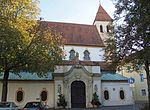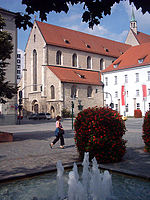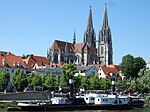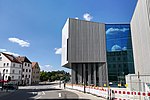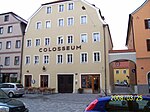Niedermünster, Regensburg
Bavarian CircleBurial sites of the Ottonian dynastyChristian monasteries established in the 8th centuryCommons category link is locally definedImperial abbeys ... and 3 more
Imperial abbeys disestablished in 1802–03Monasteries in BavariaRoman Catholic churches in Regensburg

The Niedermünster or Niedermünster Abbey (German: Reichsstift Niedermünster), Regensburg, was a house of canonesses (Frauenstift) in Regensburg, Bavaria, Germany. At the height of its power it was one of the wealthiest and most influential in Bavaria. The church is still in use as the parish church of Regensburg Cathedral.
Excerpt from the Wikipedia article Niedermünster, Regensburg (License: CC BY-SA 3.0, Authors, Images).Niedermünster, Regensburg
Niedermünstergasse, Regensburg Altstadt
Geographical coordinates (GPS) Address Nearby Places Show on map
Geographical coordinates (GPS)
| Latitude | Longitude |
|---|---|
| N 49.019444444444 ° | E 12.100555555556 ° |
Address
Niedermünster
Niedermünstergasse 3
93047 Regensburg, Altstadt
Bavaria, Germany
Open on Google Maps
